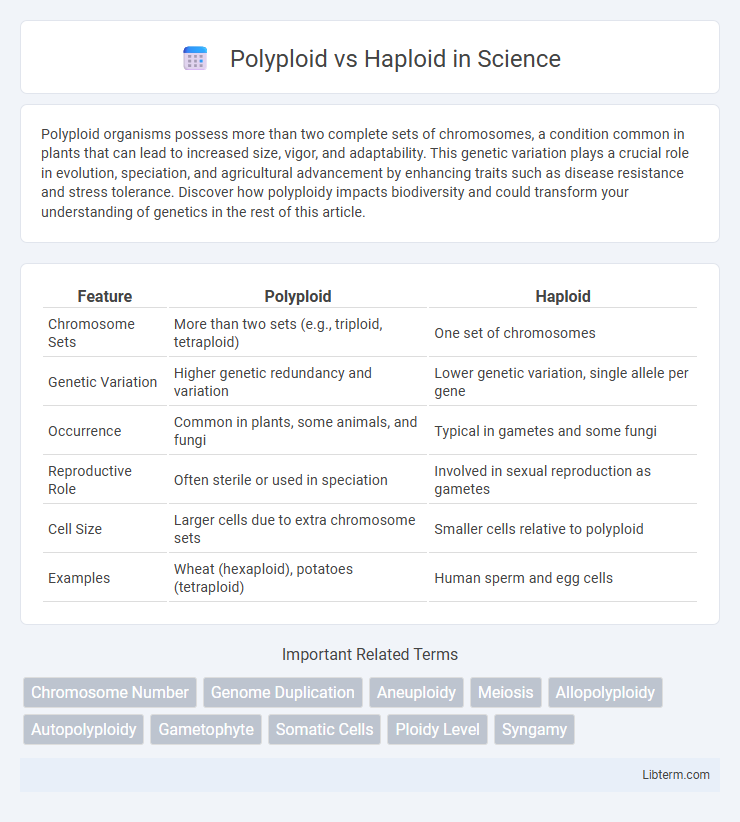Polyploid organisms possess more than two complete sets of chromosomes, a condition common in plants that can lead to increased size, vigor, and adaptability. This genetic variation plays a crucial role in evolution, speciation, and agricultural advancement by enhancing traits such as disease resistance and stress tolerance. Discover how polyploidy impacts biodiversity and could transform your understanding of genetics in the rest of this article.
Table of Comparison
| Feature | Polyploid | Haploid |
|---|---|---|
| Chromosome Sets | More than two sets (e.g., triploid, tetraploid) | One set of chromosomes |
| Genetic Variation | Higher genetic redundancy and variation | Lower genetic variation, single allele per gene |
| Occurrence | Common in plants, some animals, and fungi | Typical in gametes and some fungi |
| Reproductive Role | Often sterile or used in speciation | Involved in sexual reproduction as gametes |
| Cell Size | Larger cells due to extra chromosome sets | Smaller cells relative to polyploid |
| Examples | Wheat (hexaploid), potatoes (tetraploid) | Human sperm and egg cells |
Introduction to Ploidy Levels
Ploidy levels refer to the number of sets of chromosomes in a cell, with haploid cells containing a single set (n) and polyploid cells having multiple sets (e.g., diploid 2n, triploid 3n, or tetraploid 4n). Haploid cells are crucial in sexual reproduction, carrying half the genetic information to form a diploid zygote upon fertilization. Polyploidy plays a significant role in plant evolution and breeding, often leading to increased cell size, genetic diversity, and adaptation.
Defining Polyploid and Haploid
Polyploid cells contain multiple sets of chromosomes beyond the typical diploid number, common in plants and some animal species, enhancing genetic diversity and adaptation. Haploid cells possess a single set of unpaired chromosomes, primarily found in gametes, crucial for sexual reproduction and genetic variation. Understanding these chromosomal differences aids in studies of genetics, evolution, and breeding strategies.
Key Differences Between Polyploid and Haploid
Polyploid cells contain more than two complete sets of chromosomes, while haploid cells have a single set of chromosomes. Polyploidy is common in plants and contributes to genetic diversity and increased size, whereas haploidy is typical in gametes, facilitating sexual reproduction through fertilization. The genetic complexity and cell behavior differ significantly, with polyploids exhibiting greater adaptability and haploids ensuring genetic stability in successive generations.
Genetic Composition and Chromosome Number
Polyploid organisms contain multiple sets of chromosomes, often three or more, resulting in a chromosome number that is a multiple greater than the diploid number, while haploid cells have a single set of chromosomes. Polyploidy is common in plants and contributes to genetic variation, increased cell size, and adaptation, whereas haploids are primarily found in gametes and represent the genetic material passed to offspring. The genetic composition in polyploids is more complex due to additional homologous chromosome sets, affecting gene expression and inheritance patterns compared to the simpler, single chromosome set in haploids.
Occurrence in Nature: Polyploid vs. Haploid
Polyploid organisms commonly occur in plants, such as wheat, strawberries, and ferns, where multiple sets of chromosomes provide genetic diversity and adaptability. Haploid stages are frequently observed in the life cycles of fungi, algae, and some plants, often as a single set of chromosomes during sexual reproduction or spores. Polyploidy is rare in animals but can be found in certain amphibians and fish, whereas haploidy predominantly appears in gametes across various species.
Role in Plant and Animal Evolution
Polyploidy plays a crucial role in plant evolution by generating genetic diversity and enabling speciation through chromosome duplication, which often results in increased size, vigor, and adaptability. Haploidy, common in certain animal life stages, facilitates the expression of recessive traits and accelerates natural selection by exposing mutations directly to environmental pressures. The contrast between polyploid and haploid states shapes evolutionary trajectories by influencing reproductive mechanisms, genetic variation, and species resilience in both plants and animals.
Advantages and Disadvantages of Polyploidy
Polyploid organisms possess multiple sets of chromosomes, providing genetic redundancy that enhances adaptability, stress tolerance, and potential for increased size and vigor compared to haploid organisms with a single chromosome set. Polyploidy can lead to greater genetic diversity and evolutionary flexibility, facilitating speciation and agricultural improvement in crops like wheat and strawberries. However, polyploidy also introduces complexities such as impaired meiosis, reduced fertility, and increased metabolic demands, which can hinder stable reproduction and long-term survival.
Applications in Agriculture and Biotechnology
Polyploid plants, containing multiple sets of chromosomes, exhibit enhanced traits such as increased size, stress resistance, and improved yield, making them valuable in agriculture for crop improvement. Haploid plants, with a single chromosome set, accelerate breeding programs by enabling rapid development of homozygous lines through doubled haploidy techniques. Both polyploidy and haploidy are essential in biotechnology for generating genetically uniform plants, facilitating gene mapping, and enhancing hybrid vigor in crop production.
Implications for Genetic Diversity
Polyploid organisms possess multiple sets of chromosomes, enhancing genetic diversity by allowing greater allelic variation and increased potential for adaptation. Haploid organisms contain a single set of chromosomes, limiting genetic variation but facilitating faster genetic stability and expression of recessive traits. The increased genetic material in polyploids often leads to greater evolutionary flexibility and resilience compared to haploid species.
Conclusion: Polyploid and Haploid in Modern Science
Polyploid and haploid cells play critical roles in modern scientific research and applications, particularly in genetics, agriculture, and evolutionary biology. Polyploidy contributes to increased genetic diversity and adaptability in plants, enhancing crop improvement and resilience, while haploid cells are essential for gene mapping and mutation analysis due to their single set of chromosomes. The complementary use of polyploid and haploid models facilitates advancements in biotechnology, breeding programs, and understanding genome evolution.
Polyploid Infographic

 libterm.com
libterm.com